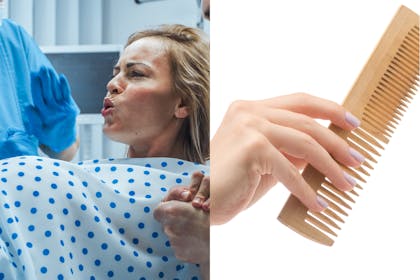Hospital trust faces firece backlash after sharing 'ridiculous' labour 'hack'

Mums weren’t impressed with the alternative pain relief method being suggested by NHS bosses
During labour, there are lots of pain relief methods to help mums as they bring their baby into the world.
From gas and air to epidurals, there’s a huge choice of options to help ease the pain of contractions and childbirth.
But now, 1 hospital trust has come under fire for suggesting that women use an everyday beauty item to help with their labour pains – with their advice causing so much controversy, it's now been removed from social media.
FREE NEWBORN NAPPIES
- Free £500 vouchers for low-income families this Christmas
- When do the clocks change in October?
- Martin Lewis issues bank account warning
- Families can apply for £150 supermarket vouchers
'Hold a comb'
Dubbed a ‘labour hack’ by Surrey and Sussex Healthcare NHS Trust's maternity department, the ‘birth comb technique’ involves women squeezing a hair comb as a distraction technique during labour.
Yes, that's the 'hack.'
In a now-deleted post, taking to Instagram to share the hack, the Trust said:
‘Holding a comb in the palm of your hand during labour can help you cope with contractions or surges.

‘There are acupressure points which lie in the crease of your palm.
‘When the comb is tightly gripped, this pressure distracts your brain and supports the body to release endorphins (feel good hormones).’
Pain gate control theory
The Trust went on to explain that the technique is based on ‘pain gate control theory’ where the brain can only focus on a certain number of sensations at one time.
‘The nerve endings in your hands are close to the skin's surface, therefore the pressure signals they send to the brain can override the pain signals being sent to your brain from contractions or surges,’ the Trust added.
‘Other methods that work on this theory include TENS machines, massages, sacral pressure and heat packs.’
'Give birthing people adequate pain relief'
However the hack was not met well.
'It's ridiculous,' one mum wrote.
‘Why don’t we just give birthing people adequate pain relief... there's an idea,' added another.
'Shove the comb'
While another added: ‘On behalf of me and the PTSD that I still have from the lack of pain relief, kindly shove the comb.’
Another said: ‘No, this is 2023 and you have no excuse not to follow evidence based medicine or medicines for pain relief.’
That said, there was some support.
Some even hailed it a ‘game changer.'
1 user, who’d tried the method commented in support, saying: ‘I did not believe a comb could help me through contractions... but to my surprise... it really did!!
'Of course along with the help of the amazing midwives, too!’
Another wrote: ‘37hrs only with a comb. Was a game changer!!’
Within a couple of days the post had been removed. Netmums has contacted the trust to ask why it has been removed.
‘Not for everyone’
In its original post, the SASH Maternity team said: ‘There are lots of different pharmacological and nonpharmacological approaches to pain-relief in labour, this has been described as a distraction technique rather than pain relief but it's something lots of people have been talking about recently.’
‘We are sure this is not for everyone and different things will work at different stages of labour but this is a technique we have been asked about and keen to share what local families have been telling us!’
‘We have a full range of pain relief options available 24/7 from birthing pools to epidurals.’
No gas and air
The ‘hack’ was particularly frustrating for some mums who had been unable to use gas and air as a pain relief method at the trust’s hospitals, after it suspended the use of Entinox (a gas and air pain relief method) over the summer.
The hospital reinstated the use of gas and air in late September, writing in an official statement: ‘On Wednesday 5 July, we took the difficult decision to temporarily suspend the use of Entonox (a gas and air pain relief method) in our maternity services at Surrey and Sussex Healthcare NHS Trust.
‘We took this action for the safety of our staff who may have had extended exposure to Entonox due to issues with ventilation in the rooms in the maternity unit at East Surrey Hospital.
‘We know this was a really concerning change for our patients, but we are pleased to report that we now have the equipment in place to make Entonox available and will be reinstating its use from today.
'We would like to thank all our patients for their continued patience and understanding, and apologise to anyone who has been affected by this temporary change.’
The trust was just 1 of a number of hospitals who suspended gas and air this year, leaving lots of mums without the use of the popular pain relief method.
What is a birth comb?
Some companies do sell official ‘birth combs’, but to try the birth comb technique you can use any comb, plastic or wooden.
The technique is suggested in hypnobirthing practice, and is a natural form of pain relief, where a mum squeezes the comb during contractions.
This comb is just £4.29 and promises to 'distract and divert the brain' during labour using the pain gate control theory.
How do I do the birth comb method?
When you feel a contraction coming or need some distraction from labour pains, hold the comb with the teeth facing towards your palm, just below the point where your fingertips meet your palm.
Squeeze using as much or as little pressure as you feel comfortable with.
What pain relief methods are available during labour?
The NHS advises individuals to speak to their midwife or doctor to find out what’s available to them, but these are some of the options. You can see the NHS’s full guidance here
Gas and air (Entonox) for labour
‘This is a mixture of oxygen and nitrous oxide gas. Gas and air will not remove all the pain, but it can help reduce it and make it more bearable. It's easy to use and you control it yourself.’
Pethidine injections in labour
‘This is an injection of a medicine called pethidine into your thigh or buttock to relieve pain. It can also help you to relax. Sometimes, less commonly, a medicine called diamorphine is used.
‘It takes about 20 minutes to work after the injection. The effects last between 2 and 4 hours, so would not be recommended if you're getting close to the pushing (second) stage of labour.’
Epidural
‘An epidural is a type of local anaesthetic. It numbs the nerves that carry the pain impulses from the birth canal to the brain. It should not make you sick or drowsy.
‘In most cases, an epidural gives complete pain relief. It can be helpful if you are having a long or particularly painful labour.
‘An anaesthetist is the only person who can give an epidural, so it will not be available at home. If you think you might want one, check whether anaesthetists are always available at your hospital.’
Remifentanil
‘Remifentanil goes into a vein in your arm. You control it yourself by pushing a button.
‘It works quickly and wears off after a few minutes. You can use it up until your baby is born.
You’ll need a small clip on your finger to measure your oxygen levels, as remifentanil can make you feel breathless or need oxygen.’
Using water in labour (water birth)
Being in water can help you relax and make the contractions seem less painful. Ask if you can have a bath or use a birth pool. The water will be kept at a comfortable temperature, but not above 37.5C, and your temperature will be monitored
TENS machines
‘TENS stands for transcutaneous electrical nerve stimulation. Some hospitals have TENS machines. If not, you can hire your own machine.
‘TENS has not been shown to be effective during the active phase of labour, when contractions get longer, stronger and more frequent. It's probably most effective during the early stages, when you may have lower back pain.
‘TENS may also be useful while you're at home in the early stages of labour or if you plan to give birth at home. If you're interested in TENS, learn how to use it in the later months of your pregnancy. Ask your midwife to show you how it works.’
Alternative methods of labour pain relief
‘You may choose alternative treatments such as acupuncture, aromatherapy, homeopathy, hypnosis, massage and reflexology. Most of these techniques are not proven to provide effective pain relief.
‘If you'd like to use any of these methods, it's important to discuss them with your midwife or doctor and let the hospital know beforehand. Most hospitals do not offer them for pain relief during labour.
‘If you want to try any of these techniques, make sure the practitioner is properly trained and experienced.’




